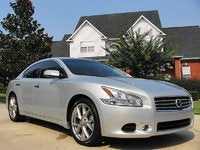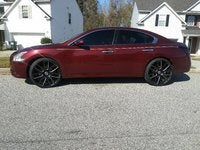Nissan Maxima Model Overview
About the Nissan Maxima
Available Now
This is not your mother's Nissan - and although you might have already guessed that by the price tag, it's not a copycat luxury faker either. Those 290 horses - they're real. Along with the upscale cabin, super-fine steering response, sleek styling and all the poise of your typical luxury brand, the latest generation of Maxima is worth every penny and even undercuts those stuffed-shirt brands by thousands when fully equipped.
However, true to Nissan's form the 2011 Maxima has gained only a few cosmetic touches since last year, and since this generation's debut in 2009 has seen only greater access to options, with a few becoming standard inclusions.
That said, the baseline S comes equipped with 18-inch alloy wheels, automatic headlights, cruise control, sunroof, keyless ignition and entry, dual-zone automatic climate control, tilt-and-telescoping steering column, power front seats, 60/40-split rear seat, leather touches, auto-dimming rear-view mirror and an in-dash 6-CD changer with an auxiliary audio jack. The S can be upgraded with the Tech or Monitor packages, affording extra multimedia and navigation gizmos.
Upgrading to the SV will fetch integrated mirror turn signals, foglamps, more driver seat comforts, full leather upholstery and a 9-speaker Bose stereo upgrade with satellite radio, and it can be upgraded with either the Premium or Sport package adding features like heated steering wheel, seats and mirrors, driver memory functions and shift paddles for some manual functionality with the continuously variable transmission (CVT).
However, unlike the other guy's CVT, this one handles the 290 hp out of the Maxima's 3.5-liter V6 like a seasoned trainer, taming that wild low-end torque steer and bringing the Maxima to 60 mph in just 6.5 seconds. At 19 mpg city and 26 highway, this CVT also affords pretty decent fuel economy with such a powerful V6. Even at 80 mph the engine doesn't rev over 2,000 rpm, leaving plenty of room for pickup and passing. Autobahn, anyone?
To top it off, this Maxima is also a blast to drive, with hair-trigger steering that does just what you expect - nothing more, but a little less at high speeds. Most drivers don't seem to notice that slight understeer, though, touting its quick pickup and zippy maneuvering just before applauding its obvious beauty without a complaint in sight.
Model History
The Nissan Maxima has been turning heads since 1977, although then it was called the Datsun 810. Winning over critics and skeptics alike, Datsun's 810 was a smash hit in the midsize sedan market with its superior performance, comfort and price.
It wasn't until the 810's second generation that the Maxima name made an appearance as the most luxurious 1981 trim, but it just barely missed the mark with a few undesirably offbeat features - like a creepy talking reminder to turn off your lights. Nevertheless, it was a fave for its style and performance, and drivers didn't seem to mind the premium price for a premium product.
The next year Datsun started becoming Nissan, and the 810 became the Maxima - of course, without a Maxima trim. For the update Datsun added only a few cosmetic touches and new headlights while keeping the original 120-hp 2.4-liter V6, standard 5-speed manual transmission, optional 3-speed automatic and rear-wheel-drive configuration. With the exception of another gear for the automatic added in '83, the Maxima remained largely unchanged until its next generation kicked off in 1985.
Most aficionados consider the 1985-'88 Maxima its second generation with Datsun now completely out of the picture, although if you have been reading along this would technically be the third generation. Semantics aside, the Maxima's '85-'88 "second" generation entered the market with front-wheel drive and several serious upgrades for both the sedan and wagon packages.
For one, the Maxima now came with a 154-hp 3-liter V6 - a full 34 horses better than its predecessor. The GL sedans and wagons came with the 4-speed automatic standard and the SE sedan could only be equipped with the 5-speed manual, but with superior improvements to its comfort, capacity, braking, suspension and overall driving dynamics, the Maxima quickly became the leader of the pack.
The Maxima went through a bit of a facelift through this generation, also renaming the baseline trim to GXE and allowing the choice of an automatic in the sportier SE. Nissan also added in a specialized suspension that detected road conditions and adjusted itself accordingly, foreshadowing the striking innovations to come for its next incarnation.
A "four-door sports car" was born in the 1989 Maxima, dropping the wagon altogether and gaining 6 hp in the 3-liter V6 with unprecedented elbow room and stunning style. The sporty SE gained a 190-hp 3-liter V6 in '92 and a retuned suspension to match, reaching 60 mph in just 7 seconds. Nissan decided to let the Maxima enjoy its perfection for an entire generation with just a few cosmetic tweaks along the way.
The 1995-'99 "fourth" generation continued in that vein, expanding the lineup to include a luxury GLE trim while adding more rear legroom with the longer wheelbase and outperforming its predecessor in every regard with a wholly new engine and driving dynamics to match - but fell short on style. It wasn't ugly, it wasn't dated - it just wasn't what drivers expected of a new Maxima.
Although the now-standard 190-hp 3-liter V6 might look the same on paper, it was completely redesigned and constructed solely of aluminum, significantly helping to shave 150 pounds from its curb weight. With record sales, this generation would also remain largely unchanged from its outset, excepting a few safety upgrades.
The 2000-'03 "fifth"-generation Maxima improved the engine yet again, this time for 222 hp out of the 3-liter V6 for every trim, and another upgrade for the '02 bumped the engine to 255 hp out of a 3.5-liter V6 with an optional CVT to improve fuel economy. Although this Maxima was the best yet in terms of performance, the interior felt cheap and sales suffered.
Taking cues from Toyota, Nissan moved Maxima production to a U.S.-based plant for the sixth generation, borrowing its Altima platform and again expanding the interior room. The move meant the end for the baseline model in favor of just 2 trims - the sporty SE and high-end SL.
While the SE had a sport-tuned suspension, 18-inch wheels, 8-speaker CD stereo, keyless entry and power accessories, the SL offered a softer ride with 17-inch wheels, heated leather seats, a 320-watt Bose stereo, wooden interior accents and plenty of other surprisingly standard accessories that would rival those found in even a modern luxury car. Aside from the move to a continuously variable transmission (CVT) over the previous automatic and manual options for 2007, the Maxima again remained largely unchanged until the latest generation debuted with the 2009 overhaul.
To ring in a completely new luxury-focused generation, the Maxima now comes as a baseline S or luxurious SV. Those 290 horses under the hood are amicably tamed by a CVT with unprecedented performance - bringing the Maxima to 60 mph in just 6.5 seconds. The drool-worthy performance and handling are all there even and especially without the Sport option package, at least in part because of its smaller stance and improved technology.
Speaking of technology, the latest generation Maxima rivals modern luxury cars with options like a hard-drive navigation system, voice recognition, real-time traffic, rear-view camera, digital music storage and iPod interface in the Tech package. The Premium package offers heated power tilt-telescoping steering wheel, driver memory functions, heated front seats, rear bucket seats and Bluetooth while the Sport package adds that and a sport-tuned suspension with 19-inch wheels.
This winning combination has held strong since the generation's debut, again holding back on any significant changes. If the pattern holds true, though, you can expect a completely revamped Maxima very soon, with all kinds of new goodies for the lover of luxury who doesn't care for those stuffed-shirt brands.
Used Versions
Used versions from the latest generation are so far rated as very reliable, having only a few annoying quirks like seat foam covering the outlets to heat and cool the seats, the gas gauge sticking, struts squeaking and the ignition lock malfunctioning. You would find all of those issues in the newest Maxima as well - along with all the same features, too - so taking $6k or more off the price is a massive bargain.
Going into the previous generation, however, will bring some issues. Only the latest model year - 2008 - doesn't have massive problems with cold starts, hard starts, ABS and belts among other things, and the $4,000 price difference between the '08 and older model years proves it.
Worse yet, most of the notorious transmission problems plaguing the previous '00 to '03 generation were not fixed until the '07 update, which replaced the traditional options with a CVT.
That said, of the older options the '96, '98, '02 - '04, and '06 - '07 model years should prove the most reliable, relatively speaking. They're all pretty awful, with the '08 leaps and bounds better, but if the transmission has been rebuilt and all the belts and sensors have been recently serviced, you should be in the clear for a while.
Used Nissan Maxima
Nissan Maxima Questions
Engine And Tranny Swap
I have an 08 maxima and engine and tranny are good..i have a chance to buy a 2012 nissan maxima will my engine and tranny and the engine cadle fit ...
Do You'll Sell Used Cars For Cash
Looking for used Nissan maxxi
Interchangeable Engine
Can I use a 2004 Nissan Murano 3.5 v6 engine in my 2004 Nissan Maxima SE 3.5 v6 ??? Both vehicles are automatic transmissions but the Murano is a rear wheel drive and Maxima is front wheel drive...
Head Gasket In A Bottle
So I have a 2012 Nissan maxima and I have a blown or Bad head gasket & I used that blue devil head gasket in a bottle stuff & I never started my car. My car won't start and my oil is like chunky ...




